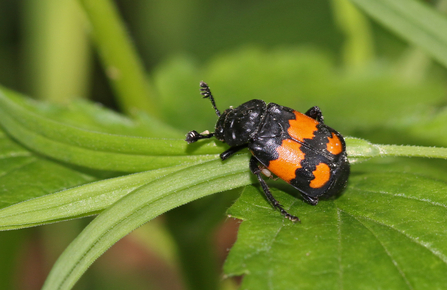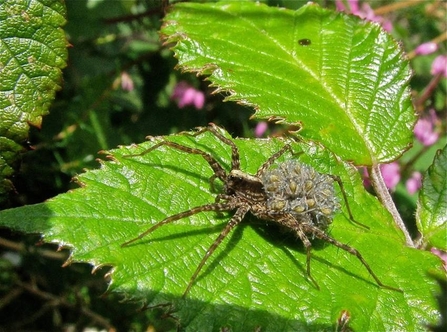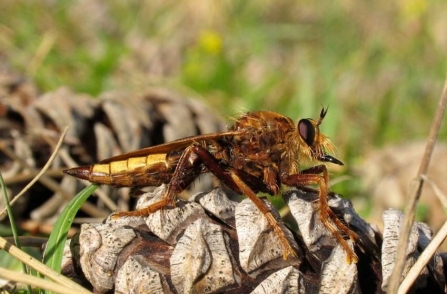It’s the time of year to delve into the dark side, so I thought we should explore the more gruesome side of the wildlife that lives on our heathlands!
Heathland horrors
Photo by Wendy Carter

Common sexton beetle by Wendy Carter
Common sexton beetle
Common sexton beetles are burying beetles, acting as the undertakers of the animal kingdom by burying dead and decaying animals like mice and small birds. Males and females come together at a carcass and will defend it against rivals to claim and bury it. The female lays her eggs on or near the buried body and the larvae feed on the decaying flesh. Surprisingly, perhaps, for the insect world, both males and females care for the larvae after they hatch, providing them with nourishment from the corpse. Their antennae have specialised receptors that can detect decomposing bodies from up to a mile away.

Female wolf spider by Rosemary Winnall
Wolf spider
Wolf spiders are the speedsters of the spider family. Unlike many other spider species, they don’t spin webs; instead, just like their namesake, they hunt their prey – chasing and pouncing on insects. Once they catch their prey, they either crush it into a ball or inject venom to turn its insides into a kind of “smoothie” that they can consume. Wolf spiders have eight dark eyes positioned around their head to give them great vision; two large eyes on top, two facing forward and four smaller ones just above their mouth.
During mating season, male wolf spiders attract females by rhythmically waving their mouthparts and legs or drumming them on leaves. After mating, the female produces a round egg sac, which she attaches to her abdomen and carries around. The young hatch inside the sac and ride on their mother’s back until they’re ready to be independent.

Hornet robberfly by Rosemary Winnall
Hornet robberfly
Measuring over an inch in length and with striking gold and black markings, hornet robberflies resemble, you guessed it, hornets. Mimicry is important in nature as it can fool potential predators into thinking you’re more dangerous to them than you are. In this case, it’s the robberfly that’s a dangerous predator to other insects.
They are skilled hunters, preying on beetles, grasshoppers, wasps and other flies. From a perch, they keep an eye on the air for movement. Once they spot potential prey, they leap into action, snatching the insect mid-air with their spiny legs. After landing, they use their piercing mouthparts to consume the body-fluids of their catch, with a thick, ginger-like “beard” protecting their mouth from struggling prey.
When the time is right, the female lays her eggs on cow, horse, or rabbit manure. Little is known about the larvae but it’s thought that they feed on dung beetle grubs in the soil below, where they spend three years of their lives. After pupating, they emerge as adults the following summer, with only five weeks to start the cycle anew.
A major threat to hornet robberflies is the use of insecticides for treating cattle, which eliminate the dung beetles that the robberflies rely on for food. Their numbers have declined and we’re lucky to have them at The Devil’s Spittleful and a handful of other places in Worcestershire. They don’t fly far so they’re particularly susceptible to local changes.
Bee wolf by John Bingham
Bee wolf
Bee wolves are large solitary wasps that are commonly found in sandy habitats, just like our heathlands, but their numbers have significantly increased recently and they’re now found in other places too.
Male bee wolves gather in a lek, where each male defends a small territory and attract females using pheromones (essentially a chemical scent). Once mated, that’s it for the males. The females, on the other hand, have a more demanding role – digging the nesting burrows (in sandy banks or floors) and filling them with food.
Their burrows can reach up to a metre in length and may contain as many as 34 side tunnels that lead to brood chambers. Once excavated, the female goes out to hunt. Primarily, they prey on honeybees, paralysing them with a sting and bringing them back to their burrow. Each chamber usually has six honeybees for the larva to feed on once it hatches. Once a chamber is full, the female will seal it before laying an egg in the next one and repeating the process. Once fully fed, each larva spins a cocoon in which to hibernate through the winter, emerging the following spring.


